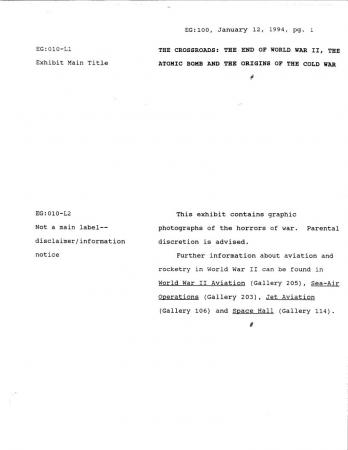In 1994, the National Air and Space Museum completed an exhibition script titled “The Crossroads: The End of World War II, the Atomic Bomb, and the Origins of the Cold War.” Over the next year, this script, and the versions following it, would generate one of the greatest controversies the Smithsonian ever experienced.

The United States dropped an atomic bomb on Hiroshima on August 6, 1945, and another on Nagasaki three days later. In the years leading up to the 50th anniversary of these attacks, National Air and Space Museum director Martin Harwit and curators Tom Crouch and Michael Neufeld imagined an exhibition that would provide a balanced look at the bombings. The original script, completed on January 14, 1994, contained five sections: "A Fight to the Finish," depicting the last year of World War II; "The Decision to Drop the Bomb," raising questions about the need to use nuclear weapons against Japan; "The World's First Atomic Strike Force," illuminating the experiences of the bomber pilots; "Cities at War" describing ground zero; and "The Legacy of Hiroshima and Nagasaki," discussing the beginning of the arms race and the Cold War. In all, the script was over 300 pages.

Plans for the exhibition began as early as 1987, and Harwit had already been in discussions with the Air Force Association while the script was under development. Once complete, he sent the script to the group for comment. Many veterans had advocated for the display of the Enola Gay, the B-29 Superfortress used to drop the bombs, as a celebration of American triumph over Japan, but there were already concerns that the Smithsonian was creating a politically correct, revisionist interpretation of the events. For many, the script only confirmed those fears. What Harwit and the curators saw as a balanced history of the bombings and their consequences, many interpreted the script as a depiction of vengeful Americans and an attempt to garner sympathy for the Japanese.
The Air Force Association publicly responded to the script on March 15, 1994. John T. Correll, Editor-in-Chief of Air Force Magazine, a publication of the Air Force Association, wrote that "many visitors may be taken aback by what they see" and "the presentation is designed for shock effect." He detailed the plans in the script to include images of melted and carbonized objects along with life-size photographs of victims and words of survivors recalling the horror of the bombs. Correll also noted that the script warns that "parental discretion is advised." He argued that this was not the objective setting that many World War II veterans envisioned when they petitioned for the display of the historic aircraft.
Under pressure from both organized groups and the general public, the National Air and Space Museum began revising the script. On May 31, 1994, the new version, retitled "The Last Act: The Atomic Bomb and the End of World War II," was completed. Three additional revised scripts were drafted between late August and late October 1994. Despite negotiations over content and presentation with both the Air Force Association and the American Legion, each version of the script was met with severe criticism.

On December 6, 1994, the museum completed a script for a supplementary segment to be placed at the beginning of the exhibition. Titled "The War in the Pacific," it was intended to create greater context for the decision to drop the bombs. Initially, it was believed that this addition would be more sympathetic to the Americans, but there were significant disagreements about the anticipated number of American casualties if the war had continued without the use of the atomic bombs.
By the end of January 1995, the Air Force Association and the American Legion had both called for the cancellation of the exhibit. Concerns in the United States Congress were expressed as early as September 1994 and only grew with threats of hearings, budget reductions, and calls for Harwit's resignation. The exhibit was officially cancelled on January 30, 1995.
That wasn't the end of the controversy, though. The cancellation sparked protest and criticism from the academic and museum communities, though arguably not as widespread as the earlier responses from the military organizations and the general public.
In addition, many Congress members were still outraged and insisted on an investigation into exhibition development practices at the Smithsonian. Harwit resigned on May 2, 1995, just days before he was scheduled to testify in Senate hearings.
On June 28, 1995, an exhibition, simply titled "Enola Gay," opened at the National Air and Space Museum. Unlike the cancelled exhibition, "Enola Gay" contained no interpretation, no graphic images, and no melted objects. Only the fuselage was on display, accompanied by basic facts and information about the plane's restoration.

The entire Enola Gay bomber is currently on display in the "World War II Aviation" exhibition at the National Air and Space Museum's Steven F. Udvar-Hazy Center.
Related Resources
- Collections related to the Enola Gay, Smithsonian Institution Archives
- The Enola Gay: A Nation's, and a Museum's, Dilemma, Editorial by Martin Harwit, The Washington Post, August 7, 1994
- Special Report: The Smithsonian and the Enola Gay, Air Force Association, March 15, 1994
- Smithsonian Cancels Exhibit on Atomic Bomb, The Baltimore Sun, January 31, 1995
- Recent Acquisition - Records from Martin Harwit, Director, NASM, 1986-1995, The Bigger Picture, Smithsonian Institution Archives
Produced by the Smithsonian Institution Archives. For copyright questions, please see the Terms of Use.

Leave a Comment